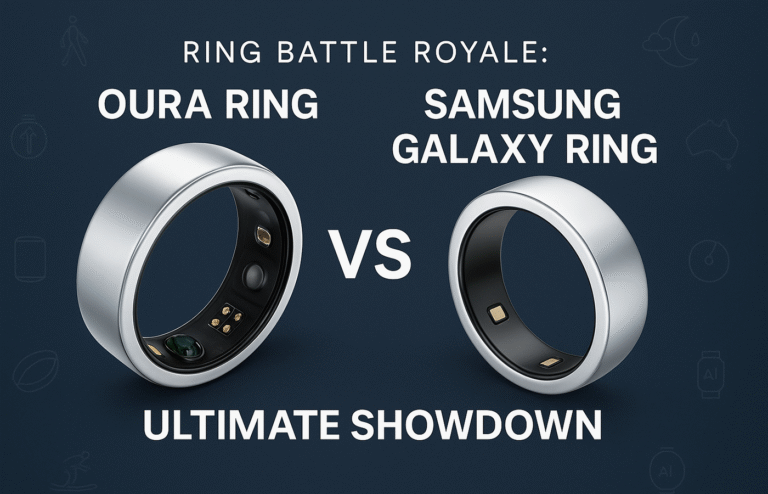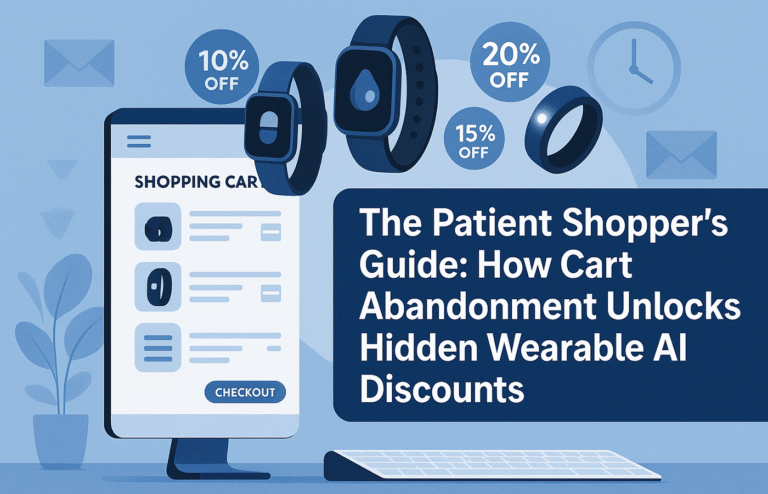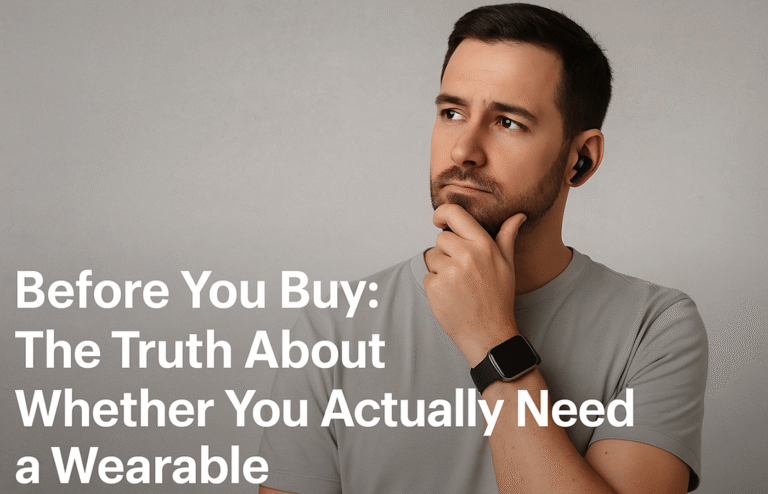Wearable AI Subscription Fees: Breaking Consumer Trust in Australia
The wearable AI market’s shift to subscription models is fundamentally changing device ownership, with hidden costs often exceeding hardware prices.
True Cost Reality:
● Oura Ring: $549 AUD device + $599.40 over 5 years = $1,148.40 total
● WHOOP: $419-629 AUD annually = $2,095-3,145 over 5 years
● Samsung Galaxy Ring: $599 AUD one-time, zero subscriptions
Consumer Impact:
● Subscription fatigue eroding trust in premium wearables
● Data hostage concerns—cancel subscription, lose historical insights
● Early adopters facing shifting terms and broken promises
Protection Strategy:
● Calculate total 5-year ownership costs before purchasing
● Consider subscription-free alternatives from Samsung, Garmin, Polar
● Time subscriptions strategically during specific training periods
● Understand Australian Consumer Law protections against misleading marketing.
Wearable AI Subscription Fees Explained: Why Smart Device Costs Are Breaking Consumer Trust in Australia
The fitness tracker revolution promised something extraordinary: the power to understand your body through data, delivered through elegant wearable devices that cost no more than a quality watch. Yet somewhere between the initial marketing buzz and today’s reality, the value proposition shifted dramatically. What began as a one-time purchase has morphed into an endless stream of subscription fees, leaving Australian consumers feeling trapped in a financial commitment they never fully understood.
Today’s wearable AI landscape has transformed from empowering technology into what many users now call ‘the great wearable paywall.’ Brands like Oura, WHOOP, and even established players are locking core features behind recurring monthly fees, fundamentally changing the relationship between consumers and their devices. Moreover, as the Australian wearables market races towards $7.31 billion by 2030, understanding these subscription models isn’t just about making smart purchasing decisions—it’s about protecting yourself from a trend that’s quietly reshaping consumer trust in the entire category.
| Australian Market Impact With the Australian wearables market expected to grow at 12.90% CAGR to reach $7.31 billion by 2030, subscription models are becoming the industry standard. Australian consumers now pay between $9.99 AUD (Oura) and $44 AUD (WHOOP) monthly—costs that can exceed the device’s original price within just two years. |
The Hidden Mathematics of Wearable Ownership
When considering a wearable AI device, most consumers focus on the upfront cost. The Oura Ring Gen 4 retails for around $549 AUD. The Samsung Galaxy Ring sits at $599 AUD. These prices seem reasonable for sophisticated health-tracking technology. However, the subscription fees tell a different story entirely.
The Oura Ring requires a $9.99 AUD monthly subscription (or $109.99 AUD annually) to access most features beyond basic daily scores. Consequently, over two years, you’ll pay an additional $239.76 AUD in subscriptions. Over five years, that climbs to $599.40 AUD—more than the ring itself cost initially. Furthermore, this doesn’t include the device cost; you’re paying $1,148.40 AUD total for the privilege of understanding your own biometric data.
WHOOP takes an even more aggressive approach. The WHOOP 4.0 operates entirely on subscription: there’s no upfront device cost, but you must commit to a membership. Australian pricing starts at $299 AUD annually (approximately $25 AUD monthly) for the basic Whoop One plan, whilst the Whoop Peak plan costs $419 AUD annually (roughly $35 AUD monthly). Additionally, the recently announced WHOOP 5.0 introduces even higher tiers, with the medical-grade WHOOP MG requiring the Life plan at $629 AUD annually. Therefore, over five years with WHOOP Peak, you’ll invest $2,095 AUD—and you’ll own nothing tangible at the end.
What You’re Actually Paying For
Wearable manufacturers justify subscriptions by pointing to ongoing costs: cloud storage, AI processing, continuous feature development, and enhanced analytics. On the surface, these explanations seem reasonable. Nevertheless, when you examine what competitors offer without subscriptions, the picture becomes murkier.
Samsung’s Galaxy Ring, priced at $599 AUD with no subscription, provides comprehensive sleep tracking, heart rate monitoring, blood oxygen measurement, and activity tracking—all accessible through the Samsung Health app at no additional cost. Similarly, Garmin’s extensive range of smartwatches offers advanced training metrics, recovery insights, and detailed health monitoring without any monthly fees. Polar, another Finnish company like Oura, provides sophisticated training analytics entirely subscription-free.
The distinction reveals an uncomfortable truth: subscriptions aren’t always about covering genuine ongoing costs. Instead, they’re often business model decisions designed to create recurring revenue streams. Whilst cloud processing and AI development do incur expenses, numerous competitors manage these costs without passing them directly to consumers through perpetual subscriptions.
| The Data Ownership Question A critical yet overlooked issue: many subscription-based wearables effectively hold your health data hostage. Cancel your subscription, and you typically lose access to historical data, detailed insights, and trending analysis—despite the fact that it’s YOUR body that generated this information. This raises serious questions about data ownership and consumer rights under Australian Consumer Law. |
The Trust Erosion Problem
Perhaps more damaging than the financial impact is how subscription models are systematically eroding consumer trust in wearable technology. Online communities and review platforms overflow with frustrated users who feel deceived by the ‘bait-and-switch’ nature of modern wearables.
The pattern is consistent: manufacturers heavily market their devices with impressive feature lists and sleek design aesthetics. However, the subscription requirement often appears in fine print or becomes apparent only after purchase. Oura, for instance, offers a one-month free trial with new devices, but after that period ends, suddenly three-quarters of the app’s functionality disappears behind the paywall.
Users report feeling trapped. They’ve invested hundreds of dollars in hardware, accumulated months or years of personal health data, and built habits around daily insights. Moreover, cancelling the subscription means losing access to this accumulated data history—a particularly bitter pill considering the device itself still functions perfectly at the hardware level.
Furthermore, the subscription fatigue phenomenon extends beyond wearables. Australians already juggle subscriptions for streaming services, cloud storage, productivity software, and numerous other digital services. Each individual subscription seems reasonable, but collectively they represent a significant ongoing expense. Consequently, adding another $10-40 monthly commitment for health tracking feels increasingly unjustifiable, particularly when the device’s hardware has already been purchased.
The Shifting Terms Controversy
Adding salt to the wound, some wearable companies have altered subscription terms for existing customers. Early Oura Ring Gen 2 users enjoyed lifetime free membership—a promise that evaporated with the Gen 3 launch. Similarly, WHOOP has adjusted pricing structures between versions, leaving long-term subscribers uncertain about future commitments. These shifting goalposts further diminish trust and make consumers wary of future wearable investments.
The Psychology Behind Subscription Fatigue
Understanding why subscription models generate such strong negative reactions requires examining the psychology of ownership. Humans naturally prefer owning things outright over perpetual rental arrangements. When you purchase a traditional watch or fitness tracker, you own it completely. It performs its functions indefinitely without additional payments.
Subscription-based wearables fundamentally change this relationship. You never truly own the full product; instead, you’re essentially renting access to your own data analysis. This creates cognitive dissonance—you’ve paid hundreds of dollars for hardware, yet the software that interprets your biometrics remains perpetually out of reach without continuous payments.
Additionally, subscription models create ongoing decision fatigue. Every month, you must re-evaluate whether the insights justify the cost. Is your sleep score worth $10? Do you really need to know your HRV trends? These recurring micro-decisions accumulate mental burden, transforming what should be a positive health tool into a source of financial stress.
How Australian Consumers Can Protect Their Wallets
Despite the subscription trend, Australian consumers have strategies to minimise costs whilst still accessing quality wearable technology:
Choose Subscription-Free Alternatives
Several excellent wearables provide comprehensive tracking without subscriptions. Samsung Galaxy Ring offers sophisticated health monitoring subscription-free, albeit exclusively for Samsung phone users. Garmin’s extensive smartwatch range delivers advanced fitness metrics, training insights, and recovery tracking without monthly fees. Polar watches provide professional-grade sports analytics entirely subscription-free. Ultrahuman Ring Air focuses on metabolic insights with no subscription requirement.
Calculate Total Cost of Ownership
Before purchasing any wearable, calculate the true five-year cost including subscriptions. A $600 subscription-free device might cost less long-term than a $300 device requiring $10 monthly subscriptions. Use this formula: (Device Cost) + (Monthly Subscription × 60 months) = True 5-Year Cost. This calculation often reveals that premium subscription-free devices offer better value.
Time Your Subscription Strategically
If you choose a subscription-based device, consider subscribing only during specific training periods or health goals. For instance, subscribe for three months whilst training for a marathon, then cancel once you’ve established baseline patterns. Many insights become repetitive after several months of consistent tracking.
Leverage Free Trials and Promotional Periods
Oura offers one month free with new purchases. WHOOP occasionally runs extended trial periods. Use these periods to extract maximum value—download your data, identify patterns, and establish healthy habits—before deciding whether ongoing subscriptions justify the expense.
Understand Australian Consumer Rights
Under Australian Consumer Law (ACL), products must match their descriptions and work as advertised. If a wearable’s marketing heavily emphasises features that are actually locked behind subscriptions, you may have grounds for complaint with the ACCC. Furthermore, ensure you understand refund policies—many retailers offer change-of-mind returns that could apply if subscription requirements weren’t clearly disclosed.
| Smart Buying Strategy For Australian consumers, the smartest approach is calculating ‘cost per insight.’ Divide the total five-year cost by the number of unique insights you’ll genuinely act upon. If you’re paying $1,500 over five years but only meaningfully change three health habits, that’s $500 per actionable insight—potentially unjustifiable compared to a one-time consultation with a sports physiologist or sleep specialist. |
The Industry’s Response and Future Outlook
Some manufacturers are beginning to acknowledge consumer backlash. Samsung’s decision to make the Galaxy Ring subscription-free was a deliberate competitive positioning against Oura. However, the company restricts the device to Samsung phone users, creating a different form of lock-in through ecosystem requirements.
Meanwhile, newer entrants are experimenting with hybrid models. Ultrahuman positions itself as the ‘anti-subscription’ smart ring, whilst RingConn offers comprehensive tracking without monthly fees. These competitors are betting that subscription fatigue will drive consumers toward their products, even at slightly higher upfront costs.
Nevertheless, the trend appears unlikely to reverse completely. Subscription models provide predictable recurring revenue that appeals strongly to investors and shareholders. Unless significant regulatory intervention occurs or consumer rejection becomes overwhelming, subscription-based wearables will likely remain dominant in premium segments.
The Verdict: Subscription Fatigue Is Real
The great wearable paywall represents more than just business model evolution—it’s a fundamental shift in how consumers relate to their health data and personal technology. Whilst subscription-based wearables can provide valuable insights, their true cost often exceeds what most Australians anticipate or find justifiable long-term.
For consumers navigating this landscape, the message is clear: calculate total ownership costs, prioritise subscription-free alternatives where possible, and approach free trials strategically. Your health data is valuable—ensure the cost of accessing it doesn’t become a source of financial stress rather than wellness insight.
As the Australian wearables market continues its rapid expansion towards $7.31 billion by 2030, the subscription model debate will only intensify. Ultimately, consumer choice will determine whether transparent, subscription-free options prevail or whether the paywall becomes the permanent price of admission to personal health insights. The power, as always, rests with your purchasing decisions and willingness to vote with your wallet.








